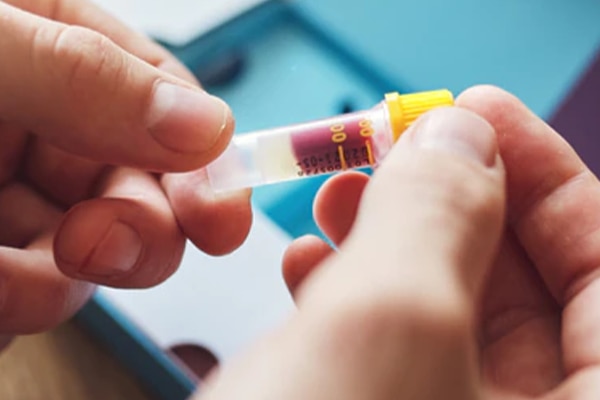15% off €35 OR 20% off €45
Testosterone imbalance: Signs, symptoms & blood tests

A testosterone imbalance can present itself in a range of signs and symptoms, producing too much or too little can have impact both your physical and mental health. Interested in knowing more about your testosterone levels? An at-home blood test may be a good place to start.
We’ve got the lowdown on what testosterone is, signs of a testosterone imbalance and how to use testosterone blood tests, below.
First things first:, what is testosterone? And what does it do?
Testosterone is a major sex hormone that both women and men produce, although . testosterone levels are naturally much higher in men. It's known for being responsible for sexual development in men during puberty. However it also plays a musch more significant role in the health and wellbeing of both sexes.
In men, this hormone is that is responsible for:1
- The development of the penis, testes and prostate gland
- The deepening of the voice during puberty
- Body, facial and pubic hair growth
- The strength and growth of muscles Controlling bone mass2
- Regulating sex drive (Libido)
- Sperm production


Women need a healthy balance of testosterone for the following functions:3
- The growth, maintenance, and repair of reproductive tissues
- Sex drive
- Strong and healthy bones
- Normal cognitive function4
Although guidance does vary,testosterone levels lower than 10 nanomole per litre (nmol/l) are generally categorised as low testosterone in men.5
Testosterone levels do decline naturally with age – they peak during adolescence and then start to gradually decrease by about 1% each year after the age of 30.6 7
Signs of low testosterone can include:8 9
- Low sex drive
- Fatigue
- Erectile dysfunction
- Reduced lean muscle mass, exercise tolerance and strength
- Irritability
- Depression Anxiety
Handpicked content: The 10 best foods to increase testosterone


6 symptoms of low testosterone levels in women
6 symptoms of low testosterone levels in women
Although testosterone levels naturally decrease as you get older, entering the menopause is one of the leading causes of low testosterone in women.10 While testosterone levels in women are naturally lower than in men, studies have shown that symptoms of low testosterone in women can include: 11 12
- Low sex drive
- Vaginal dryness
- Lack of energy
- Irregular menstrual cycle
- Feeling less satisfied with sex
- Weaker bones


It’s worth bearing in mind that the Endocrine Society guidelines say that a diagnosis of androgen deficiency (low testosterone) in healthy women cannot be made purely based on symptoms alone.13, So if you do think you may have low testosterone, it is a good idea to get your levels tested.
Studies show that testosterone has a direct effect on bone metabolism and health.14 Long-term, this means that the risk of osteoporosis is much higher in those with low testosterone levels.15
Polycystic Ovarian Syndrome (PCOS) affects around 1 in 10 women in the UK, and yet despite its prevalence, the diagnosis of this common condition remains confusing.16
17 Although a diagnosis can be hard and frustrating to achieve, one of the defining features of PCOS is hyperandrogenism – a hormonal imbalance caused by the ovaries creating excess male hormones (including testosterone). This imbalance presents itself in the form of a few common PCOS symptoms:18
- Excess facial hair (hirsutism)
- Irregular periods
- Acne
- Bald spots
If you are interested in knowing more about your testosterone levels, taking a at-home testosterone test may give you better understanding before seeking further advice from your doctor.
Testosterone blood tests FAQs
If you want to find out more about your testosterone levels, an at-home test can provide clarity or peace of mind. Especially if you feel you’d rather understand your testosterone levels before speaking to a doctor about any symptoms you may be experiencing.
Once you open up your at-home testosterone blood test, you should find:
- Lancet for the finger prick
- 1 or 2 blood collection tubes
- A pre-paid return envelope
You should take a testosterone test first thing in the morning (between 7 am and 10 am), as research has shown that this is when your testosterone levels are at their highest.19 20
How to use at-home testosterone blood tests
So how is testosterone tested? There are a couple of options. You could go the traditional route of booking an appointment with your GP, or you could try an at-home test first to get quick results.
Here’s some guidance on using at-home testosterone kits:
- Clean your space – to ensure that your results are accurate, both your surroundings and your hands need to be clean and dry.
- Read the instructions – as with anything health related, reading the information carefully is vital.
- Conduct the test – this usually involves pricking your finger, using your opposite hand to gently squeeze the blood out and collecting it in a blood collection tube.
- Package it up – seal everything off as per the instructions and pop your sample in the post in the paid-for envelope.
Once the lab receives your sample, you’ll get your results after they’ve been analysed by the experts.


Testosterone tests can be useful regardless of your sex. Plus, you can skip the long process of arranging an appointment and get your results ready for when you next see your doctor.
The advice in this article is for information only and should not replace medical care. Please check with your GP or healthcare professional before trying any interventions.
1 https://www.royalberkshire.nhs.uk/media/hj4cdq2n/hypogonadism-trt_jan21.pdf
2 https://www.ncbi.nlm.nih.gov/pmc/articles/PMC5036835/
3 https://www.ncbi.nlm.nih.gov/pmc/articles/PMC5434832/
4 https://academic.oup.com/jcem/article/99/10/3489/2836272
5 https://pubmed.ncbi.nlm.nih.gov/19011285/
6 https://www.jahonline.org/article/S1054-139X(14)00225-0/fulltext
7 https://www.nhs.uk/conditions/male-menopause/
8 https://www.centreformenshealth.co.uk/what-are-normal-male-testosterone-levels
9 https://www.kch.nhs.uk/wp-content/uploads/2023/01/pl-934.1-testosterone-replacement-therapy.pdf
10https://my.clevelandclinic.org/health/diseases/24897-low-testosterone-in-women
12 https://ro.co/health-guide/low-testosterone-in-women/
13 https://academic.oup.com/jcem/article/99/10/3489/2836272
14 https://www.ncbi.nlm.nih.gov/pmc/articles/PMC5376477/
15 https://www.royalberkshire.nhs.uk/media/hj4cdq2n/hypogonadism-trt_jan21.pdf
16 https://www.nhs.uk/conditions/polycystic-ovary-syndrome-pcos/
17 https://www.ncbi.nlm.nih.gov/pmc/articles/PMC1069067/
18 https://cks.nice.org.uk/topics/polycystic-ovary-syndrome/





